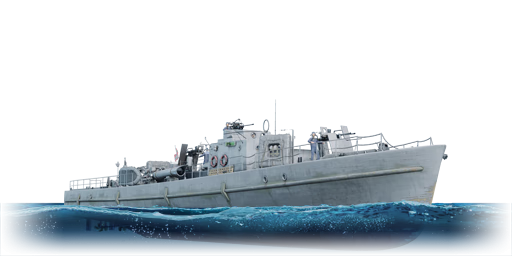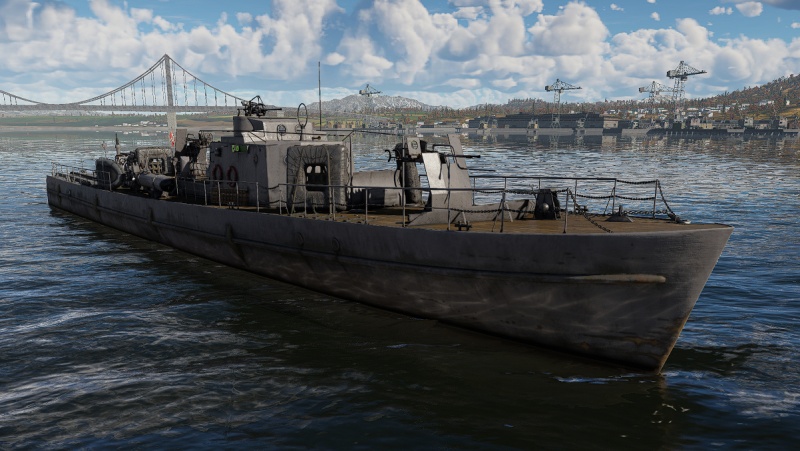R-301
Contents
Description
The R-301-class, R-301 is a rank II German motor torpedo boat with a battle rating of 2.3 (AB/RB/SB). It was introduced in Update 1.79 "Project X" as part of the fleet closed beta test.
General info
Survivability and armour
The R-301 is constructed using wood, the superstructure is hardened wood constructed to a thickness of 12 mm. The wooden construction of the R-301 means fire is one of the biggest threats to survival of the ship. There is no armour on the ship, apart from the gun shields and hardened superstructure. The R-301 has a crew complement of 42, increased by 1 compared to the R-boot R-130. The R-301 still provides a great attachment of sailors, which helps to increase the overall survivability of the R-301 dramatically compared to other ships in this tier.
Compared to the previous version R-boot R-130 which only offered two single 2 cm/65 C/30 (20 mm) automatic cannons and a single 3.7 cm FlaK-Lafette C/36 (37 mm) automatic cannon. This is now significantly increased even more with two twin 2 cm/65 C/38 (20 mm) automatic cannons, replacing the two single 2 cm/65 C/30 automatic cannons with twice as much stopping power and 200 round magazines for them. Additionally, the legendary single 3.7 cm FlaK-Lafette C/36 automatic cannon stays the same, the depth charge racks are replaced with two torpedo tubes are added.
However, the internal components of the R-301 are spaced out, meaning a good volley of enemy fire will not completely incapacitate the ship.
- The engine is placed, under the conning tower of the ship, with the transmission extending towards the stern (Rear) to the Voith Schneider propulsion system.
- The transmission & propeller systems are under the waterline, which protects it from most enemy rounds, which would penetrate the ship.
- The engine's system can be destroyed by enemy fire since it extends above the waterline.
- The ship's fuel and ammunition storage can be penetrated by enemy fire, since these are located above the waterline.
Mobility
The R-301 may seem slow in comparison to the other naval ships at this tier, due to its length. The Voith Schneider propulsion system, as found on the R-41 & R-130 has been replaced with a conventional three bladed propeller and transmission system. The engines have been increased from two to three.
The top speed has been increased by the change of propulsion system:
- In arcade, it has a maximum speed of 57 km/h.
- In realistic & simulator is 43 km/h.
However, the change from the Voith Schneider to the conventional blades has had a significant change on the manoeuvrability of this ship. It is incapable of performing the once fine manoeuvrable dance acts of the previous Voith Schneider propulsion system, which powered the R-boot R-41 & R-boot R-130.
Modifications and economy
Armament
Primary armament
The R-301's main armament consists of five 2 cm FlaK 38 automatic cannons. One dual mount in front of the bridge protected by a 8 mm hardened armour shield, one single mount directly behind bridge with no crew protection and one dual mount amidship between torpedo tubes, protected by the same shield as the other dual mounts. Due to the railing around the ship and the gunshields protecting the guns, they are unable to shoot directly in front of the ship up to about 400 m away. There are three ammunition types available:
- Universal: AP-T · AP · HEF-T · HEF
- 20 mm HET belt: HEF · HEF-T · HEF · AP
- 20 mm APT belt: AP · AP-T · AP · HEF
| Penetration statistics | |||||||||
|---|---|---|---|---|---|---|---|---|---|
| Shell | Type of warhead |
Penetration @ 0° Angle of Attack (mm) | |||||||
| 10 m | 100 m | 500 m | 1,000 m | 1,500 m | 2,000 m | ||||
| 20 mm HEF-T | HEF-T | 2 | 2 | 2 | 2 | 2 | 2 | ||
| 20 mm AP | AP | 36 | 35 | 27 | 20 | 15 | 11 | ||
| 20 mm AP-T | AP-T | 36 | 35 | 27 | 20 | 15 | 11 | ||
| 20 mm HEF | HEF | 2 | 2 | 2 | 2 | 2 | 2 | ||
| Shell details | |||||||||
|---|---|---|---|---|---|---|---|---|---|
| Ammunition | Type of warhead |
Velocity (m/s) |
Projectile mass (g) |
Fuse delay (m) |
Fuse sensitivity (mm) |
Explosive mass (TNT equivalent) (g) |
Ricochet | ||
| 0% | 50% | 100% | |||||||
| 20 mm HEF-T | HEF-T | 835 | 120 | N/A | 0.1 | 10.54 | 79° | 80° | 81° |
| 20 mm AP | AP | 785 | 150 | N/A | N/A | N/A | 47° | 60° | 65° |
| 20 mm AP-T | AP-T | 785 | 150 | N/A | N/A | N/A | 47° | 60° | 65° |
| 20 mm HEF | HEF | 835 | 120 | N/A | 0.1 | 10.54 | 79° | 80° | 81° |
Secondary armament
The R-301 is also armed with a single 3.7 cm SK C/30 cannon located on the stern. Due to the very low rate of fire at only 30 rounds per minute, the gun is not very useful for surface combat.
| Penetration statistics | |||||||||
|---|---|---|---|---|---|---|---|---|---|
| Shell | Type of warhead |
Penetration @ 0° Angle of Attack (mm) | |||||||
| 10 m | 100 m | 500 m | 1,000 m | 1,500 m | 2,000 m | ||||
| 37 mm Spgr L/4.1 Lh 37 | HE | 2 | 2 | 2 | 2 | 2 | 2 | ||
| 37 mm Psgr L'spur Zerl | APCBC | 87 | 84 | 71 | 58 | 48 | 39 | ||
| Shell details | |||||||||
|---|---|---|---|---|---|---|---|---|---|
| Ammunition | Type of warhead |
Velocity (m/s) |
Projectile mass (g) |
Fuse delay (m) |
Fuse sensitivity (mm) |
Explosive mass (TNT equivalent) (g) |
Ricochet | ||
| 0% | 50% | 100% | |||||||
| 37 mm Spgr L/4.1 Lh 37 | HE | 1,000 | 820 | 0 | 0.1 | 27.4 | 79° | 80° | 81° |
| 37 mm Psgr L'spur Zerl | APCBC | 1,000 | 820 | 1.3 | 15 | 37.5 | 48° | 63° | 71° |
Additional armament
The R-301 features two torpedo tubes, one on each side of the hull. These fire standard German 533 mm G7a torpedo which can be found on most of the other Kriegsmarine vessels. With a speed of 81 km/h, a payload of 358.4 kg TNTe and range of 6 km while not upgraded with torpedo mode, these make them one of the best torpedo in its class, surpassed only by Japanese Type 93 Long Lance family. When upgraded with torpedo mode, the speed decrease to 56 km/h while maximum range change to 14 km. The R-301 can also carry up to 10 EMC moored contact mines on the slides astern behind the 3.7 cm cannon. Each of these mines have a warhead of 384 kg TNTe, capable of sinking any vessel that will sail near them. However, using the mines comes at the cost of having them exposed on the deck and risking a fatal explosion to your vessel when hit.
Usage in battles
Describe the technique of using this ship, the characteristics of her use in a team and tips on strategy. Abstain from writing an entire guide – don't try to provide a single point of view, but give the reader food for thought. Talk about the most dangerous opponents for this vehicle and provide recommendations on fighting them. If necessary, note the specifics of playing with this vehicle in various modes (AB, RB, SB).
Pros and cons
Summarise and briefly evaluate the vehicle in terms of its characteristics and combat effectiveness. Mark its pros and cons in the bulleted list. Try not to use more than 6 points for each of the characteristics. Avoid using categorical definitions such as "bad", "good" and the like - use substitutions with softer forms such as "inadequate" and "effective".
Pros:
Cons:
History
Developed in the inter-war period, the R-Boots (Raumbootes) were designed as minesweepers, and they had deliberately low draughts in order to operate close to the coast. The armament was limited due to the intended mission of the ships. Propulsion was provided by two MAN marine diesel engines, providing 1,836 horsepower each and driving two shafts. Construction utilized a metal understructure and wooden framing.
424 R-Boots were completed, and they continually saw service up until 1945. They were notably used during the 1940 invasion of Norway. Only 140 of these ships survived the war, with many captured by the Allies or divided up between the Allies as spoils of war. 24 R-Boots were eventually reintroduced to the West German Navy and operated until the 1960s.
The R-Boots, despite being built as minesweepers, were forced into other roles during the war. They were used for search-and-rescue (SAR), ship hunting, coastal patrol, and convoy escort, among other duties such as minelaying. The ships were rarely used in their intended role (minesweeping) because of the defensive nature of the war for the Kriegsmarine.
R-301 was the lead ship of an R-Boot class, significantly larger than the preceding R-218. It had a length of 41 m and a displacement of 160 tons. This class consisted of R-301 through R-312, and the class was constructed from 1942 to 1945. The biggest change from the preceding classes of R-Boot was the addition of two 533 mm torpedo tubes, for use against enemy surface vessels. The R-301 class also added a third screw for increased speeds, up to 24 knots.
Media
- Skins
See also
Links to articles on the War Thunder Wiki that you think will be useful for the reader, for example:
- reference to the series of the ship;
- links to approximate analogues of other nations and research trees.
External links
Paste links to sources and external resources, such as:
- topic on the official game forum;
- other literature.
| Abeking & Rasmussen Schiffs- und Yachtwerft Aktiengesellschaft | |
|---|---|
| Minesweepers (Räumbooten) | |
| Type R-130 | R-130 |
| Type R-301 | R-301 |
| Germany boats | |
|---|---|
| Motor torpedo boats | LS 3 · LS 4 Esau · KM-5 · VS-10 |
| S-38 · S-38b · S-100 · S-147 · S-204 Lang · S-701 | |
| R-301 | |
| V-990 | |
| Jaguar · Hugin · Pfeil | |
| Motor gun boats | R-41 · R-130 · Krischan der Große |
| Motor torpedo gun boats | Albatros · Bussard · MZ1 · Pr. 206 |
| Minelayers | VS-8 |





